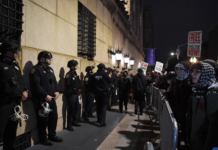KUALA LUMPUR,Feb 8: This year’s celebration of Chinese New Year will be rather unique and admittedly, somewhat dour, no thanks to the Covid-19 pandemic.
However, despite the general gloom, some quarters are taking steps to ensure that Chinese culture continues to be promoted through scaled-down celebrations.
Thean Hou Temple in Kuala Lumpur happens to be the scene of one of these endeavours, as this year’s celebrations are held in accordance with the theme of “Turning over a Niu Leaf”.
“Niu” means “cow” or “ox” in English.
The theme is meant to dispel the unfortunate rat of yesteryear, and usher in a resourceful year filled with longevity.
In the same vein, the temple hopes to welcome the prosperous ox which will bring onto Malaysia great wealth and health.
Hence, to welcome the Year of the Ox, the temple committee has decided to revive a rare Chinese tradition called, “Whipping the Spring”.
This tradition involves the erection of a 148.6 sq m structure resembling a yellow paddy field, the symbol of a good harvest.
Aside from the paddy field, a rustic attap house, a pair of buffaloes and a lone farmer can be seen, against the backdrop of a peaceful farm basking in the morning sunlight.
This is quite the scenery that any shutterbug would fall in love with at first sight.
But this elaborate structure is more than just mere decoration, as it has symbolic significance.
The tradition of “Whipping the Spring” is also sometimes known as “Whipping the Spring Ox” or “Welcoming the Spring Ox”.
In the past, on the first day of the spring season, villagers would whip a buffalo, signifying the beginning of spring ploughing and expressing their wishes for a good harvest.
During the first crack of the whip, the villagers would wish for fine weather.
The second crack of the whip would be followed by a wish for fertilised soil.
The third, fourth, fifth and sixth whip were meant to represent wishes for an auspicious beginning, favourable seasons, a good harvest and all-rounded exuberance.
These whippings are also supposedly a way to rid oneself of bad luck and sorrow while welcoming a new phase of one’s life.
While people may not be able to leave their homes to visit the magnificent structure any time soon, the temple intends on keeping it around for visitors to view after the MCO is lifted.
The pandemic has affected the temple’s plans for the year rather adversely, with multiple celebrations, charity drives, gatherings and competitions having to be cancelled or shifted online.
Amidst all the doom and gloom though, the temple and its devotees remain steadfast in its belief that the pandemic will eventually come to its timely end.
And when Malaysians are finally free to travel, Thean Hou Temple will be waiting to welcome any and all visitors wishing to take in the beautiful sceneries to be found within the temple grounds.



















